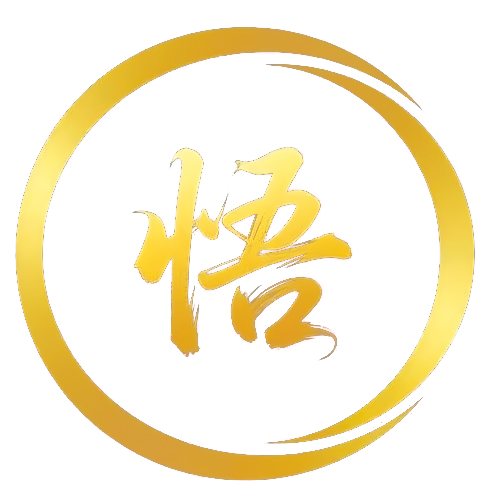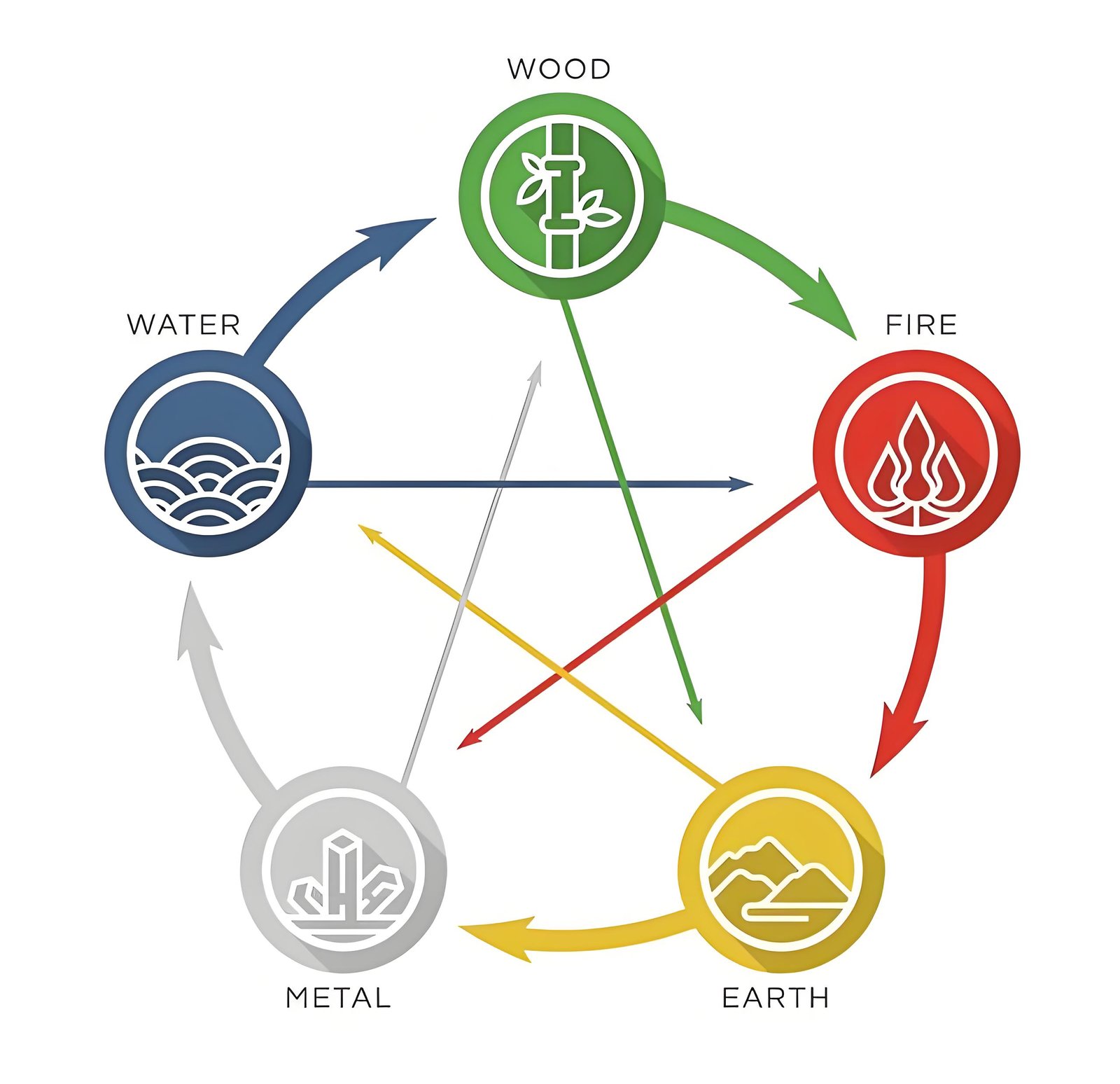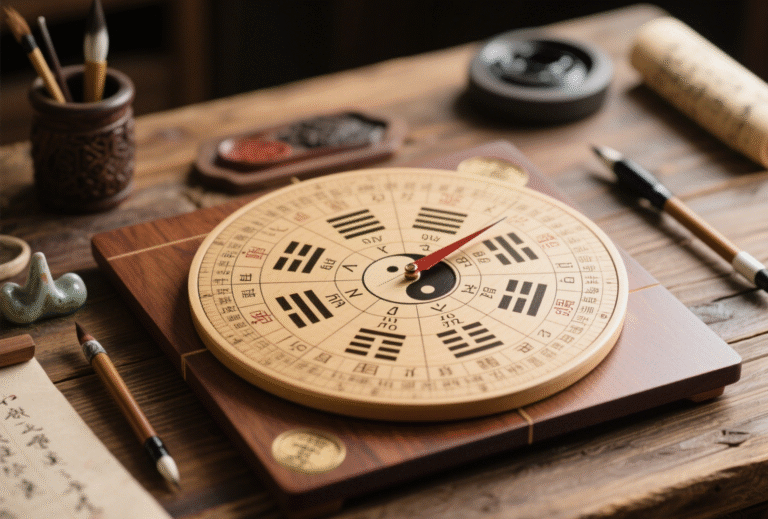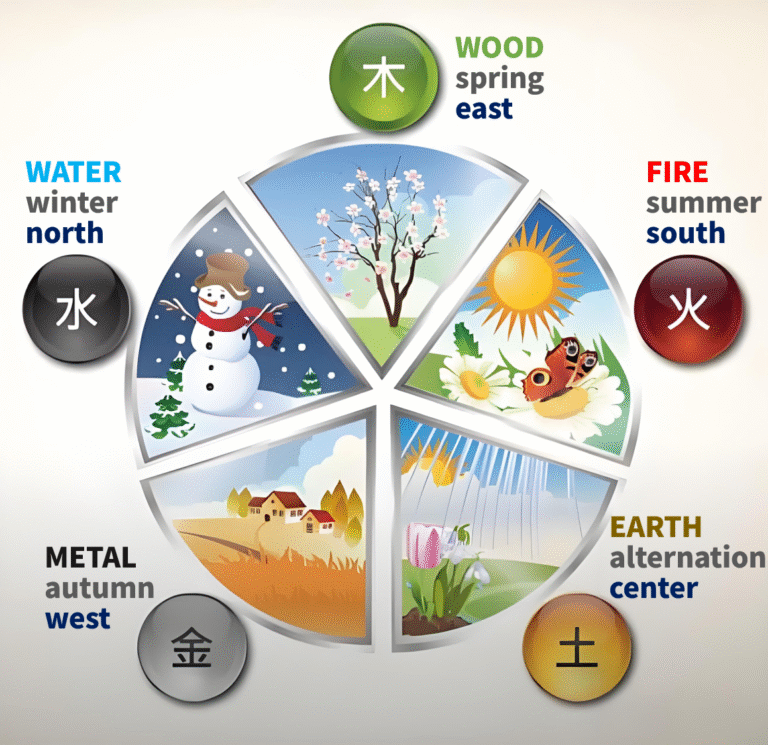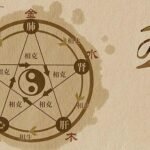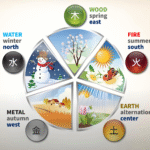Imagine ancient thinkers trying to explain how everything in the world works and connects using a simple yet powerful system. That system is the Five Elements (Wu Xing) – a core idea in Chinese culture passed down for thousands of years. It’s not just the foundation of fortune-telling systems like Four Pillars (Ba Zi), but also deeply influences Traditional Chinese Medicine (TCM), Feng Shui, and even traditional arts.
What are the Five Elements?

Simply put, the Five Elements are Wood (Mu), Fire (Huo), Earth (Tu), Metal (Jin), and Water (Shui). Don’t think of them only as literal trees, flames, soil, gold, or rivers. They are better understood as five fundamental states of energy or patterns of movement:
- Wood (Mu): Represents growth, expansion, upward movement, and vitality. Like plants sprouting in spring, full of life and energy.
- Fire (Huo): Represents heat, light, upward surge, dynamism, and transformation. Like the blazing summer sun, full of passion and activity.
- Earth (Tu): Represents stability, grounding, nourishment, integration, and balance. Like fertile soil, supporting and nurturing all life. It’s the center and harmonizer.
- Metal (Jin): Represents contraction, condensation, refinement, structure, and descent. Like metal in autumn – strong, precise, focused. Symbolizes harvest and organization.
- Water (Shui): Represents flow, descent, coolness, adaptability, depth, and potential. Like water or ice in winter – fluid, mysterious, holding hidden power.
The Core Relationships: The Cycles of Nourishment and Control

The magic of the Five Elements lies in the constant interplay of two fundamental relationships, creating an endless cycle of energy flow:
- The Nourishing (Sheng) Cycle: One element feeds, supports, or creates the next element.
- Wood nourishes Fire: Wood burns to create Fire.
- Fire nourishes Earth: Fire burns down to ash, becoming Earth.
- Earth nourishes Metal: Metal ores are formed and found within the Earth.
- Metal nourishes Water: Metal surfaces collect dew (an ancient observation), or molten metal flows like water.
- Water nourishes Wood: Water provides the moisture trees need to grow.
- 👉 Remember the Cycle: Wood -> Fire -> Earth -> Metal -> Water -> (back to) Wood
- The Controlling (Ke) Cycle: One element checks, regulates, or restrains another element, preventing it from becoming excessive.
- Wood controls Earth: Tree roots break up and hold (but also consume) soil.
- Earth controls Water: Earth (like a dam) absorbs and channels Water, stopping floods.
- Water controls Fire: Water extinguishes Fire.
- Fire controls Metal: Fire melts Metal.
- Metal controls Wood: Metal tools (axes, saws) cut down Wood.
- 👉 Remember the Cycle: Wood -> Earth -> Water -> Fire -> Metal -> (back to) Wood

Why are Both Cycles Essential?
Think about it:
- If only the Nourishing Cycle existed (e.g., Fire endlessly creating Earth with no check), energy would spiral out of control, leading to chaos and excess.
- If only the Controlling Cycle existed (e.g., Water constantly putting out Fire with no support), energy would be stifled, leading to stagnation and decay.
- Nourishing (Sheng) and Controlling (Ke) are two sides of the same coin, both vital. Together, they create a dynamic, self-regulating system of balance. This constant push and pull maintains harmony in everything – from the vast natural world down to human health and individual destiny. This perfectly embodies the ancient Chinese concept of Yin-Yang – the idea that opposing yet complementary forces exist in all things.
What is Wu Xing Used For?
- Understanding the World: The ancients used Wu Xing to explain natural phenomena like seasonal changes (Spring=Wood, Summer=Fire, Late Summer=Earth, Autumn=Metal, Winter=Water), directions, colors, tastes, emotions, and even organs in the human body (e.g., Liver=Wood, Heart=Fire, Spleen=Earth, Lungs=Metal, Kidneys=Water).
- Prediction & Adjustment: In practices like Four Pillars (Ba Zi) astrology, analyzing the strength and interactions of the Five Elements in a person’s birth chart is believed to reveal personality traits, potential, life challenges, and fortune. The goal is to identify imbalances (e.g., an element too strong or too weak) and find ways to harmonize them through lifestyle, environment, career, color choices, names, etc.
- Foundation of Chinese Medicine (TCM): TCM views health as a state of balance among the organ systems (each linked to an element). Illness often stems from elemental imbalances, and treatment involves adjusting these energy relationships (e.g., “nourishing Water to support Wood” or “strengthening Earth to nourish Metal”).
- Feng Shui & Environment: Feng Shui analyzes the landscape and built environment (mountains, water, buildings, layouts – each associated with elements) to understand the flow of energy (Qi) based on the Sheng and Ke cycles. It aims to create harmonious spaces that support the occupants’ well-being.

A Key Point: Balance & Change
The core principle of Wu Xing is dynamic equilibrium. No single element is inherently “good” or “bad.” What matters is the harmony of their relationships and the relative balance of their strengths. If one element becomes too powerful (e.g., excessive “Fire”), it might overly “control Metal” or excessively “nourish Earth,” and could even overpower the element that normally controls it (“Water” in this case – known as “reverse control” or “insult”). Similarly, an element that is too weak destabilizes the whole system. Understanding and adjusting this balance is the essence of applying Wu Xing wisdom.
In Summary:
The Five Elements (Wood, Fire, Earth, Metal, Water) are ancient China’s ingenious way of mapping the universe’s fundamental energies and patterns. Through the constant interplay of the Nourishing (Sheng) and Controlling (Ke) cycles, they form a dynamic, self-balancing system. This theory is widely applied to understand nature, predict destiny (e.g., in Ba Zi), guide health practices (TCM), and design harmonious environments (Feng Shui), all centered on the pursuit of harmony and balance.
Hope this explanation helps unlock the ancient wisdom of Wu Xing for you! Which part did you find most interesting or surprising?

